When you travel, is there any way you can “follow the money” to ensure that whatever you spend on your trip stays local and benefits the communities you visit? This article offers a few ideas on how to do that and highlights some movements and methodologies afoot in the travel industry that might help.
“For every US$100 spent on a tour holiday by a tourist, only around US$5 actually stays in a developing-country destination’s economy.” – United Nations Environmental Programme (UNEP)
This statistic gets me every time I see it.
You spend your money on travel — shouldn’t it benefit the places you visit? You spend money locally — that money stays local, doesn’t it?
That all depends. And according to the data, not always. The technical term for the phenomenon of money spent on travel to or in a destination ending up in foreign hands: leakage.
Having worked in the travel industry for over a dozen years, we understand how leakage occurs — especially where foreign owners, foreign employees, and imported food and supplies dominate. While visiting Nepal recently, I read that although the number of visitors to the country is back on the rise after the earthquake in 2015, dollars spent per visitor is declining, in part due to leakage. Among the leakage factors at work: tour packages by Indian and Chinese tour operators and payment systems that bypass Nepal’s financial system almost entirely. The most predatory and extractive form of leakage by design is something referred to as “zero dollar tourism.”
Outside of the worst examples, the majority of the tourism industry exists in shades of grey. Ascertaining the extent to which your travel dollars — spent on tours, experiences, accommodation, transportation, and food — remains within a local economy can be difficult.
However, some companies and organizations are raising awareness of the issue and providing travellers some basic tools to help follow their travel money. This includes measurement frameworks which consider whether suppliers are locally owned. A concept known as the Ripple Score developed by G Adventures and the Planeterra Foundation is one such measurement.
Other multi-stakeholder efforts involving NGOs, community organizations and local tour operators are also underway. We recently completed an assignment with the MEET Network, a consortium of Mediterranean protected areas developing conservation-focused ecotourism products. Among the elements of their rigorous methodology is a supplier assessment survey which ensures the selection of majority locally-owned suppliers to deliver products featured in the consortium’s catalog.
Impact of keeping tourism money local: Employment and the multiplier effect
Why are we interested in keeping tourism money local in the first place?
To answer that, let’s briefly re-examine how tourism expenditure can positively impact local communities.
According to the World Travel and Tourism Council (WTTC) an estimated one in ten jobs around the world is linked to travel and tourism.
No matter what your relationship to the travel industry, this is remarkable to consider. But how does this work?
The typical travel experience features a number of different touchpoints, each with the opportunity to work with local businesses, social enterprises and organizations. Travelers need to sleep (accommodation), eat (restaurants and markets), get from one place to another (transport), and to shop (souvenirs, crafts, gifts). Not to mention to experience (tours, guides, sights), which is what likely motivated the trip in the first place.
In ideal circumstances, money spent on travel that “lands” locally provides employment, increases income generating opportunities for small and family businesses, and spurs the creation of new services and businesses. It can even motivate government investment in community infrastructure, help preserve cultural heritage and aid in the conservation of environmental resources.
Most importantly, these economic inter-relationships help local families support themselves.
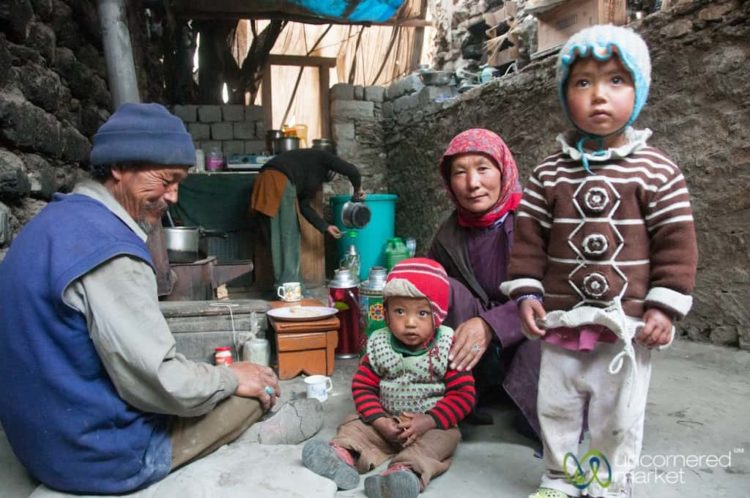
When a travel-related good or service is sourced locally – e.g., food for restaurants, supplies for hotels, etc. — the initial local business is not only supported, but its suppliers are also. This stitches together a widening fabric of socioeconomic impact as tourism money spent threads its way into other adjacent areas of the local economy. This phenomenon of spreading impact is known as a multiplier or ripple effect.
Take, for example, when our tour group stayed at a community homestay in Madagascar on our G Adventures tour. The money paid for our visit to the coordinating community organization not only helps employ several part-time local staff (e.g., guide, cook, etc.), but it’s also used to purchase vegetables, meat and other items from sources nearby.
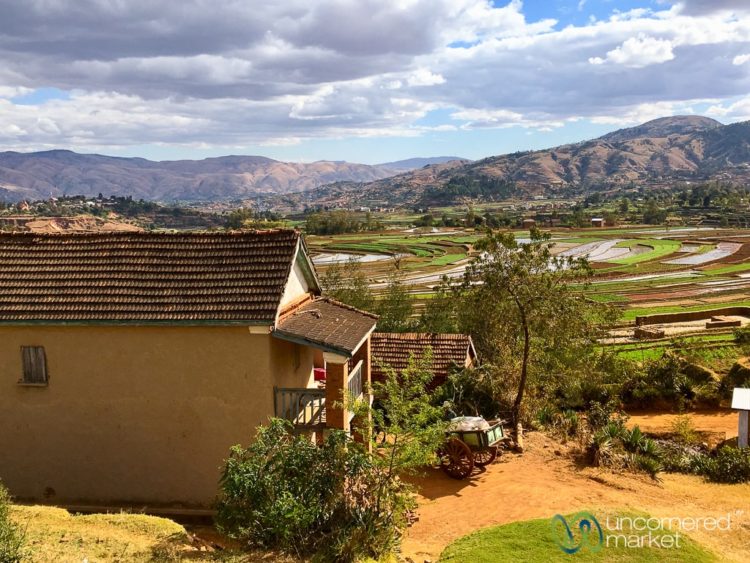 Our village homestay in Madagascar benefits neighbouring farmers by buying local.
Our village homestay in Madagascar benefits neighbouring farmers by buying local.This provides local farmers a fair and reliable market price for their food. As tour frequency increases, it can also save farmers from a time-consuming trip to a regional market several hours away where they might have earned even less for their products. The economic ripple moves outward through the community as farmers’ additional earnings are likely spent locally on home improvements, food, and other services.
Spending local for independent travellers
If you travel independently, here are a few ways you can maximize the impact of your tourism money. We understand these suggestions may be obvious. However, we’ve learned over the years that they’re more challenging than they sound:
- stay at locally owned hotels, guesthouses or other accommodation
- eat at local restaurants
- take local transportation (e.g., public or private)
- buy locally made souvenirs, ideally where you can buy directly from the artisan
- book experiences with local guides and experts
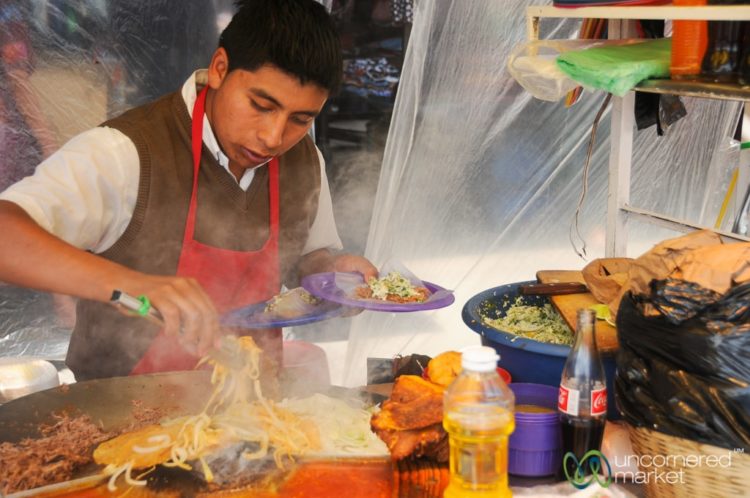 Eating local is often more fun, too. Taco stand in Guatemala.
Eating local is often more fun, too. Taco stand in Guatemala.Try also to spread money around to different local businesses. The idea isn’t to switch hotels daily, but instead to use this as an organic travel tactic to experience a wide variety of food, shopping and other services that a destination has to offer.
Spending local with organized tours
When selecting an organized tour, you can also apply an equivalent “go local” logic, choosing a tour company which hires local businesses to deliver the various components of its tours, including accommodation, food, transport, and guides.
It all sounds simple enough, doesn’t it? In practice, it’s not no easy. Consider your own choices of accommodation, restaurants, or other travel-related services: How do you really know if each of the businesses you engage with is locally owned? How do you know if the money you spend remains local?
Follow the money: The why and how of the Ripple Score
“A tour company is only as good as the component parts that make up its tours,” Jamie Sweeting, CEO of Planeterra Foundation, said as he explained the rationale of a measurement framework it and G Adventures refer to as Ripple Score.
The measurement — an effort to “follow the money” — intends to examine the extent to which G Adventures works with locally owned providers of accommodation, transport, restaurants, and other services. It also aims to approximate, by percentage, how much tour money spent on local services actually remains in the local economy.
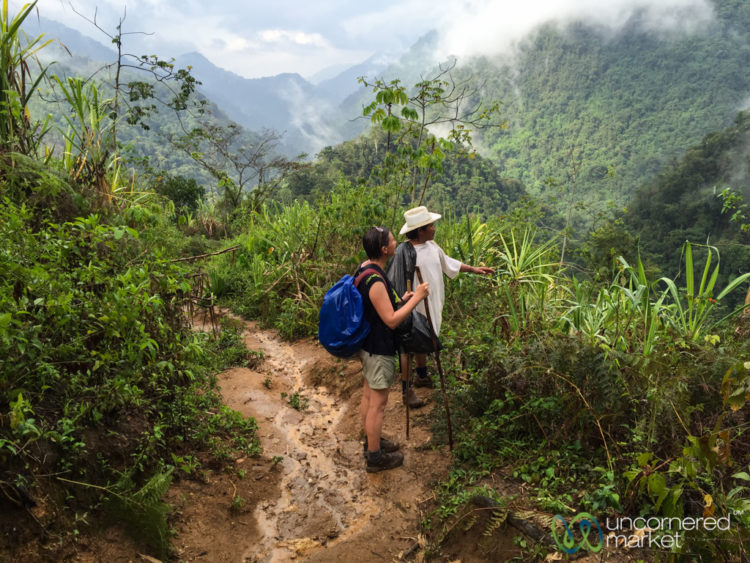 Our Lost City Trek in Colombia engaged a local Wiwa-owned company and hired indigenous guides.
Our Lost City Trek in Colombia engaged a local Wiwa-owned company and hired indigenous guides.Although an existing survey known as G Local collected data about local impact and sustainability activities of suppliers, a greater and more specific measure was needed. G Adventures, together with its partners Planeterra Foundation and Sustainable Travel International, landed on the following question it would ask all its suppliers around the world: “Is 50% or more of your business owned by a national citizen or permanent resident of the country it operates in?”
If a business met this threshold, it would be considered locally owned and its portion of the cost of tour services would be considered as having remained in the local economy.
A similar approach is applied by the MEET Network, a client who engaged us earlier this year to consolidate and assess their ecotourism development methodology, one which blends conservation-focused product development with a rigorous measurement framework. In line with the network’s brand values, suppliers of product components must be locally owned. The rationale for such a requirement is akin to a rule-of-thumb we suggested a mindful independent traveler might apply. The aim: to ensure that money spent on its ecotourism products remains in its partner communities and protected areas.
Planeterra’s Sweeting, who helped lead the rollout of the Ripple Score and has a background in sustainability certification and measurement methodologies, admits that one supplier ownership question does not constitute a precise local impact measurement. It’s possible, of course, for locally-owned businesses to source everything from abroad and to hire foreign workers. Similarly, it’s possible for foreign-owned businesses to invest heavily in local communities. But research shows that locally owned businesses tend to keep and spend the money locally rather than sending it elsewhere.
The Ripple Score, acknowledged as neither a replacement for measuring leakage nor for multiplier analysis, instead offers a first-step method for G Adventures to both validate the assertion that it “works with local companies” and to consider how that assertion might be quantified and understood by the company and its customers.
While it’s easy to criticize this measurement approach as an oversimplification, it’s important to note that G Adventures does business with over 7,000 services delivered through 2,000 suppliers throughout 800+ tours in more than 100 countries across its product portfolio. While the Ripple Score could be seen as imprecise, it’s a start.
Beyond offering consumers a shared language around the local impact of their travel dollars spent with the company, the Ripple Score also helps identify gaps and areas of improvement for G Adventures. Tours with low Ripple Scores highlight opportunities where the company might better discover and engage local suppliers.
Furthermore, it provides competitive motivation for other tourism companies to begin asking themselves similar questions. Imagine if all tour operators around the world did the same and shared this information — and how it was compiled — with consumers.
How travellers can use the Ripple Score
Here’s how the Ripple Score is calculated.
First, it’s determined whether each business is majority locally owned or not (1 or 0). Then, this is multiplied by the amount attributable to the service provided by the business. For example, if a supplier answered “yes” and provided $250 of services in a tour where $2,500 was spent locally, their component score would be 10%. If the supplier answered “no”, then it would be 0%. All component scores are then added to calculate the total Ripple Score for the tour.
If you see a Ripple Score of 100 – the maximum possible — on a G Adventures tour, that’s an indication that 100% of the suppliers used on that tour are majority locally owned. A score below 100 indicates that one or more suppliers is not locally owned.
 A tour’s Ripple Score is indicated for almost all G Adventures tours.
A tour’s Ripple Score is indicated for almost all G Adventures tours.For example, our recent Wonders of Brazil tour featured a Ripple Score of 100. Same with the Highlights of Madagascar tour we took last year. What does this mean in practice? It implies that all accommodation we stayed in during the tour was locally owned. Same goes for the local guides and tour companies engaged for all included and optional activities, as well as for the transportation and meals included in the tour fee.
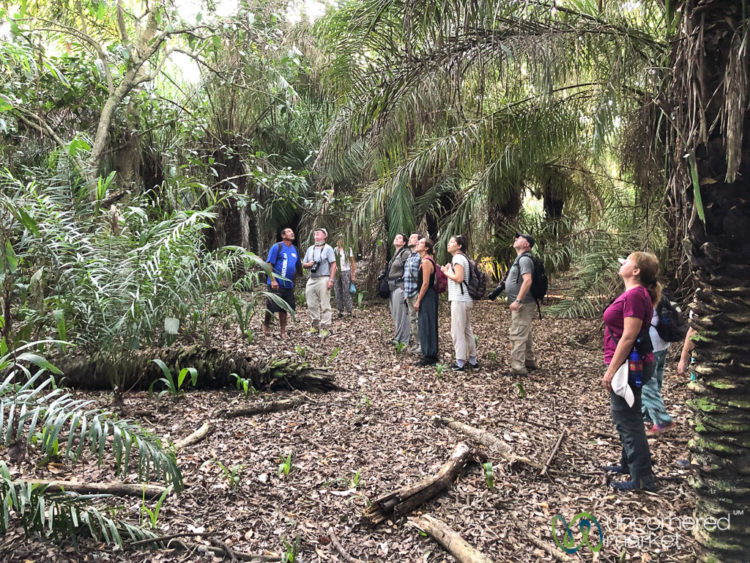 An early morning walk with a local guide, organized by a locally-owned hacienda in the Pantanal, Brazil.
An early morning walk with a local guide, organized by a locally-owned hacienda in the Pantanal, Brazil.If I see a Ripple Score of 100 does that mean that the entirety of the tour price ends up in the local economy? Not likely. The tour price include other costs of doing business such as commission for resellers and travel agents, marketing expenses, staff costs, administrative overhead and other costs.
Although the original concept for the Ripple Score was to comprehend the total tour price, G Adventures opted first to focus on the money spent inside the destination for each tour to avoid the trap of inconsistency posed by the variability of certain cost components like sales commissions.
Following your travel money: It’s a journey
A growing number of travellers demand that travel purchases deliver economic benefit to local communities. As awareness of our individual and collective impact grows, so too will the sophistication of frameworks to understand and measure that impact. Tools like the Ripple Score and sustainable tourism supplier assessments will continue to evolve and aid in economic transparency.
A few years from now, perhaps we will be able to take for granted that all travel products and tours will incorporate a common local economic benefit measurement methodology and score. When we spend $100 on a vacation we’ll know how much of that remains in the community. Attention to that figure might help raise it dramatically from today’s $5.
Until then, travel consumers must continue to ask questions and demand clarity and transparency from travel companies.
It will be good for travellers. It will be for the good of the industry.
And most importantly, it will be in respectful service to the communities we visit.
The post How Do You Know Your Travel Money Stays Local? appeared first on Uncornered Market.